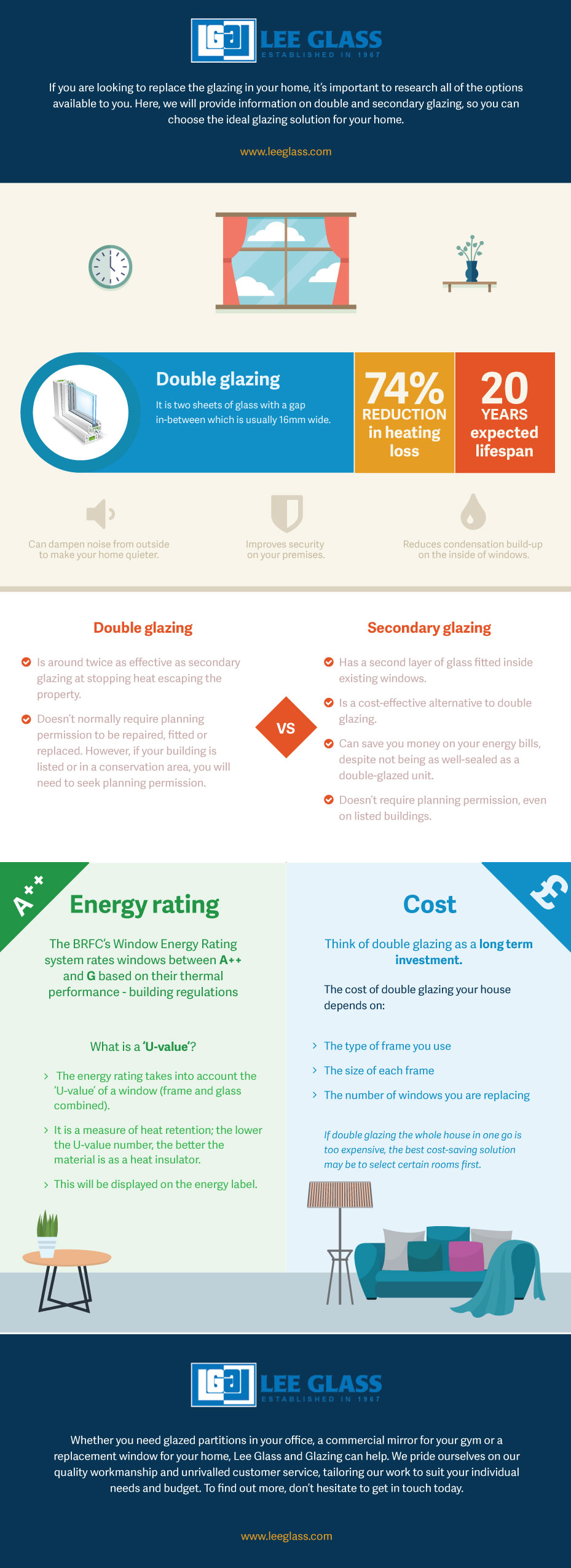Double glazing vs Secondary Glazing
Whether your glazing is reaching the end of its life expectancy or you are looking to make your home more energy efficient, there’s no better time than now to research the glazing options available to you. To aid your decision-making, this article will take an in-depth look into double glazing and secondary, so you can choose the ideal glazing solution for your home.

What is double glazing?
Many homeowners often overlook the importance of making sure their windows are sufficiently glazed. Double glazing features two sheets of glass with a gap between them – usually 16mm wide – which assists in improving comfort levels and functionality within the home.
Benefits include:
- Enhanced security; it is much more difficult to break than single glazing
- Sound insulation; double glazing can minimise noise levels from outside for a quieter home
- Expected lifespan of around 20 years
- Reduces condensation inside windows
- Reduces heat loss through windows so there are fewer draughts and your home is kept warmer. In turn, this leads to reduced heating bills.
- Reduces window heat loss by 74%
- Available in a variety of frame materials, including uPVC and traditional wood, to complement your property.
- Compatible with low emissivity (Low-E) glass which lets sunlight and heat in whilst reducing the amount of heat that escapes through the window.
Double vs secondary glazing
Secondary glazing involves fitting a second layer of glass inside your existing windows, offering an efficient, cost-effective alternative to double glazing, which is particularly useful for homes in listed buildings.
Despite not being as well sealed as a double-glazing unit, secondary glazing could still save you some money on your energy bills. That said, double glazing is approximately twice as effective as secondary glazing at stopping heat escaping the home.
Planning permission is not usually required to install, repair or replace double glazed windows, except if the building is listed or in a conservation area. If this is the case, you will need to seek advice from your local planning authority before having anything installed.
On the other hand, secondary glazing doesn’t require planning permission, even on listed buildings. As such, secondary glazing may be the only suitable option for improved thermal insulation if you live in a listed building.
What are the costs involved?
As with any work carried out on a property, it’s important to consider the costs involved. Double and triple glazing are considered a long term investment, so you should not expect to reap the rewards overnight.
Whilst it typically takes a long time to see a return on this investment through energy savings alone, you will immediately see the effects of improved comfort levels and security, as well as an increase in the resale value of your home.
When it comes to the cost of double glazing your property, you will need to take into account the following:
- The type of frame you use
- The size of each frame
- The number of windows you are replacing
If double glazing your entire house is proving too expensive, one way to save money would be to choose certain rooms to double or triple glaze first, rather than glazing the whole house in one go.
Energy ratings
Finally, when choosing the perfect type of glazing for your home, make sure you keep an eye out for their energy ratings. Similar to the energy labels found on white goods and household appliances, the BRFC’s Window Energy Rating system rates windows between A++ and G based on their thermal performance; it’s worth noting that building regulations require all new windows to be at least C-rated.
Using this information, you can find how much money you are saving in your property using the GGF’s energy saving calculator.
The energy rating also takes into account the ‘U-value’ of the whole window (frame and glass combined). This is a measure of how easily heat can pass through the material; the lower the U-value number, the better the material is as a heat insulator.
Lee Glass and Glazing
For first class glazing and an unrivalled customer service, look no further than the specialists here at Lee Glass and Glazing. With over 45 years’ experience, we can facilitate your entire glazing project, from boarding up broken windows to repairing steamed up/misted windows. Whether you require our services for your home or commercial application (such as a shop, office or restaurant), we can help – simply get in touch with our expert team today to find out more.








